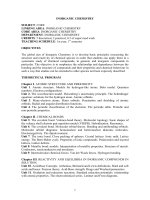A very basic inorganic Chemistry
Bạn đang xem bản rút gọn của tài liệu. Xem và tải ngay bản đầy đủ của tài liệu tại đây (224.96 KB, 21 trang )
BASIC CHEMISTRY
CIVL270-Maraqa
Units of Measurement
Basic
units and conversion factors
Quantity
SI Units
Conversion Factor
USCS Units
Length
m
3.2808
ft
Mass
kg
2.2046
lb
Temperature
o
C
1.8(oC)+32
Area
m2
10.7639
ft2
Volume
m3
35.3147
ft3
Velocity
m/s
2.2369
mi/hr
Flow rate
m3/s
35.3147
ft3/s
kg/m3
0.06243
lb/ft3
Density
Appendix A in the textbook contains conversion factors
o
F
Prefixes
CIVL270-Maraqa
Quantity
Prefix
Symbol
10-9
nano
n
10-6
micro
10-3
milli
µ
m
10-2
centi
c
10-1
deci
d
10
deka
da
102
hector
h
103
kilo
k
106
mega
M
109
giga
G
Periodic Table
Source: />
Appendix B in the textbook contains atomic weights of elements
What is Concentration?
The mass (or volume) of solute per unit mass (or volume) of solution.
+
=
Solute
Solvent
•Solid
•Liquid
•Liquid
•gas
•gas
Solution
Commonly Used Units of Concentration
For liquid
mass of solute
volume of solution
mass of solute
mass of solution
example
example
mg
L
mg
= ppm
kg
For dilute aqueous
solution
1 mg/L= 1ppm
For gases
volume of solute
volume of solution
example ppm (by volume)
mass of solute
volume of solution
CIVL270-Maraqa
example
mg
m3
The relation between
ppm and mg/l for
gaseous solutions
depends on pressure,
temperature and
molecular weight
The ideal gas Law: P V=n R T
Pressure
Volume
Gas constant
0.082 (L.atm/K.mol) (see Appendix C)
Temperature
(K=273+oC)
Number of moles
To convert from ppm to mg/m3 for gases use
mg ppm × molecular weight 273.15 K P (atm)
=
×
×
m3
22.414
T (K )
1 atm
Example 1.2
Convert 9 ppm CO to mg/m3 at 1 atm and 25oC.
Solution
CIVL270-Maraqa
mg 9 × 28
273.15 K
1 atm
=
×
×
= 10.3
3
m
22.414 (273 + 25) K 1 atm
Other Concentration Units
Molarity (M) =
moles of solute
volume of solution (L)
Moles of solute =
mass of solute
Molecular weight
mass of solute/L
Normality =
equivalent weight
Equivalent weight =
CIVL270-Maraqa
MW
equivalent number
Kinetics
xA
yC + zD
The rate of change of A with
respect to time, if the reaction is
irreversible, takes the form:
d[A]
= −k[A]a
dt
Concentration
Reactions take time to reach equilibrium. This time could
be very short or very long.
C
A
Time
Constant determined
experimentally.
Reaction
rate constant
Many reactions rates in the
environment are modeled d[A] = −k[A]a
dt
as first-order (i.e. a=1):
CIVL270-Maraqa
D
[A ] = [A o ]e − kt
Stoichiometry
Consider the following balanced chemical reaction
a X+ b Y
cZ
The equilibrium constant (K) for this reaction is defined as:
[ Z ]c
; [ ]= molar concentration.
K=
a
b
[ X ] [Y ]
If the chemical is in the solid state or pure liquid then its [ ]=1.
If the chemical is in the gaseous form, then its [ ]= its partial
pressure (P).
In-Class Exercise (Example 2.2 modified)
2 M of C6H12O6 are completely oxidized to CO2 and H2O. Find the amount of
oxygen required to complete the reaction.
Solution:
The balanced reaction is:
1C6H12O6 + 6O2
6CO2 + 6H2O
1C6H12O6 M requires 6O2 M
2 M requires
?O2 M
O2 = 6x2= 12 M
= (12 M)(32 g/mol)
= 384 g/L
Note: K for the above reaction is written as
[ H 2O(l ) ]6 [CO2 ( g ) ]6
6
PCO
2
K=
=
[O2 ( g ) ]6 [C6 H 12O6 ( aq ) ] PO62 [C6 H12O6 ( aq ) ]
CIVL270-Maraqa
Reactions
Transform
Chemical
Coordination
partner transfer
Oxidation-reduction
Transfer
Biological
Aerobic degradation
Volatilization
Anaerobic degradation Sorption
Ion exchange
Sedimentation
CIVL270-Maraqa
Example Coordination Partner Transfer Reactions
Acid-base rxns
H2O
H+ + OH
Solubility product
CaCO3 (s)
[ H + ( aq ) ][OH − ( aq ) ]
K w=
= [ H + ][OH − ] = 10 −14 at 25o C
[ H 2O( l ) ]
Ca
2+
(aq)
(aq)
+ CO
Solubility of gases
CO2(g)
CIVL270-Maraqa
CO2(aq)
23 (aq)
K H=
2−
K sp= [Ca 2+ ][CO3 ] = 5 × 10 −9
[CO2 ( aq ) ]
PCO2
= 0.033 (mol / L.atm)
Solubility Product (Ksp)
Solubility of Gases (KH)
Equilibrium Equation
Ksp at 25oC
T(oC)
CO2
O2
CaCO3 = Ca2+ + CO3 2-
5×10-9
0
0.0764
0.00218
CaSO4 = Ca 2+ + SO4 2-
2×10-5
10
0.0532
0.00169
Cu(OH)2 = Cu 2+ + 2(OH)-
2×10-19
15
0.0454
0.00152
Al(OH)3 = Al 3+ + 3(OH)-
1×10-32
20
0.0391
0.00138
25
0.0333
0.00126
Ca3(PO4)3 = 3Ca
2+
CaF2 = Ca 2+ + 2F-
CIVL270-Maraqa
+ 4PO4
3-
1×10
-27
3×10-11
In-Class Exercise (Example 2.9)
Find the solubility of fluoride ions in water caused by the
dissolution of CaF2.
Solution
CaF2 (s)
Ca 2+ (aq) + 2F-(aq)
Ksp=[Ca2+][F-]2= 3x10-11
Assume [Ca] = s
[F]= 2s
(s)(2s)2=3x10-11
s= 2x10-4 mol/L
[F]= 2(2x10-4)= 4x10-4 mol/L
= (4x10-4 mol/L) (19 g/mol) (103 mg/g) = 7.6mg/L
CIVL270-Maraqa
Organic Chemistry
Organic
compounds contain carbon except compounds such as CO, CO 2,
CO3.
Organic compounds
compounds
Organic
Aliphatic
Aliphatic
Cyclic
Cyclic
Saturated
Saturated
(Paraffins)
(Paraffins)
Unsaturated
Unsaturated
(Olefins)
(Olefins)
Aromatic
Aromatic
Hydrocarbons:
Organic compounds that contain H and C.
Alkanes (single bond): Methane (CH ), Ethane (C H ) , Propane (C H ),
4
2 6
3 8
Butane (C4H10), Pentane (C5H12), Hexane (C6H14), Heptane (C7H16),
Octane (C8H18), Nonane (C9H20), Decane, (C10H22) etc.
Alkenes
(double bond): Ethene (C2H4), Propene (C3H6), etc.
Alkynes
(triple bond): Ethyne (C2H2), Propyne (C3H4), etc.
}
Examples
CH3 CH
CH3
CH3
CH2
CH2
CH3
CH3
Butane
2-methylpropane
CH3
CH3
C
Cl H
CH3
CH2
CH3
CH
Those compounds have the
same chemical formula
(C4H10) but different structure.
They are called isomers
CH3
Cl C
2,2,4-trimethyl pentane
Cl Cl
Cl C C F
F F
1,1,2-trichloro-1,2,2-trifluoroethane (CFC)
C H
1,1,1-trichloroethane
(TCA)
Cl H
Cl Cl
C
C
Cl H
Trichloroethylene (TCE)
Examples
H
H
C
C
C
H
C
=
C
C
CH3
H
CH3
Benzene
1,2-dimethyl benzene
(o-xylene)
H
H
CH3
CH3
Methyl benzene
1,3-dimethylbenzene
(Toluene)
CH3
(m-xylene)
CH3
CH3
1,4-dimethylbenzene
(p-xylene)
CIVL270-Maraqa
Organic Compounds with Functional Groups
•Alcohols: contain (-OH) group attached to aliphatic
H
H-C -OH
Methanol
H
•Phenols: contain (-OH) group attached to aromatic
OH
Phenol
•Aldehyde: contain
O
C-H
group
O
H-C-H Formaldehyde
CIVL270-Maraqa
•Ketones:
•Ethers:
contain
group with carbon
atom attached to carbon atoms
contain(-O-) group
O
-C -
O
H3C-C-CH3
acetone
•Carboxylic acids:
contain
O
-C -OH
group
O
-C-OH
H3C-O-CH3
Dimethyl ether
•Amines:
contain (-NH2) group
H3C-CH2-NH2
Benzoic acid
CIVL270-Maraqa
Ethyl amine
Organic Compounds of Environmental Concern
Trihalomethanes (THMs): These compounds are
present in chlorinated waters.
BTEX: benzene, toluene, ethylbenzene, and xylene.
Polynuclear Aromatic Hydrocarbons (PAHs):
naphthalane, anthracene, etc.
Polychlorinated Biphynels (PCBs).
Pesticides: Example dichlorodiphenyltrichloroethane
(DDT).
CIVL270-Maraqa









